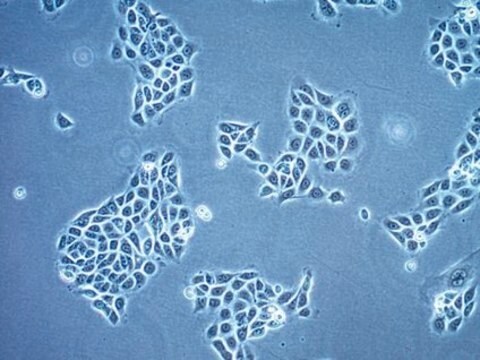NCI-H358
NOTE: Both the cell line and DNA from the cell line may be available for this product. Please choose -1VL or VIAL for cells, or -DNA-5UG for DNA, 95111733, human lung (bronchoalveolar), Not specified
Zaloguj sięWyświetlanie cen organizacyjnych i kontraktowych
About This Item
Kod UNSPSC:
41106514
Polecane produkty
pochodzenie biologiczne
human lung (bronchoalveolar)
opakowanie
tube of 5 μg 95111733-DNA-5UG
pkg of vial of cells 95111733-1VL
tryb wzrostu
Adherent
kariotyp
Not specified
morfologia
Not specified
produkty
Not specified
receptory
Not specified
metody
cell culture | mammalian: suitable
powiązane choroby
cancer
Warunki transportu
dry ice
temp. przechowywania
−196°C
Pochodzenie linii komórkowej
Ludzki rak oskrzelowo-pęcherzykowy rasy kaukaskiej
Opis linii komórkowej
NCI-H358 został wyizolowany z pierwotnego raka oskrzelowo-pęcherzykowego płuc od mężczyzny rasy kaukaskiej pobranego przed leczeniem. Badania ultrastrukturalne tego niedrobnokomórkowego raka płuc (NSCLC) wykazały obecność ziarnistości charakterystycznych dla komórek Clara. NCI-H358 nie wykazują ekspresji UDP-glukuronozylotransferazy, ale wykazują ekspresję glutationo-S-transferazy i sulfotransferazy fenolowej. Wykryto ekspresję białka i RNA SP-A, głównego białka związanego z surfaktantem. RNA SP-B i SP-C nie ulegało ekspresji. Stwierdzono całkowitą homozygotyczną delecję genu p53, a tym samym brak białka p53. Odnotowano wydajność tworzenia kolonii na poziomie 0,83% w miękkiej agarozie i wzrost w pożywce bez surowicy. Komórki są nowotworotwórcze u atymicznych nagich myszy i wykazują czas podwojenia wynoszący 38 godzin w pożywce RPMI 1640. Ponieważ komórki te są biegłe w utlenianiu ksenobiotyków, ale mają niedobór koniugacji z kwasem glukuronowym, stanowią narzędzie do analizy roli koniugacji kwasu glukuronowego w inaktywacji substancji chemicznych w nienaruszonych komórkach.
Zastosowanie
System testowy do oceny cytotoksyczności i genotoksyczności chemikaliów dla ludzkich płuc
Profil DNA
Dane STR-PCR: Amelogenina: X,Y
CSF1PO: 11,12
D13S317: 8,12
D16S539: 12,13
D5S818: 10,12
D7S820: 10,11
THO1: 6
TPOX: 8,9
vWA: 17
CSF1PO: 11,12
D13S317: 8,12
D16S539: 12,13
D5S818: 10,12
D7S820: 10,11
THO1: 6
TPOX: 8,9
vWA: 17
pożywka hodowlana
RPMI 1640 + 2mM Glutaminy + 5-10% Płodowej Surowicy Bydlęcej (FBS).
Rutyna subkultury
Rozdzielić subkonfluentne hodowle (70-80%) w stosunku 1:3 do 1:6, tj. wysiać 1-3x10 000 komórek/cm2 przy użyciu 0,25% trypsyny lub trypsyny/EDTA; 5%CO2; 37°C.
Inne uwagi
W przypadku przesyłek w regionie Azji i Pacyfiku mogą obowiązywać dodatkowe opłaty za transport i obsługę. Więcej informacji można uzyskać u lokalnego przedstawiciela działu obsługi klienta.
Ta strona może zawierać tekst przetłumaczony maszynowo.
Wybierz jedną z najnowszych wersji:
Certyfikaty analizy (CoA)
Lot/Batch Number
It looks like we've run into a problem, but you can still download Certificates of Analysis from our Dokumenty section.
Proszę o kontakt, jeśli potrzebna jest pomoc Obsługa Klienta
Masz już ten produkt?
Dokumenty związane z niedawno zakupionymi produktami zostały zamieszczone w Bibliotece dokumentów.
Nasz zespół naukowców ma doświadczenie we wszystkich obszarach badań, w tym w naukach przyrodniczych, materiałoznawstwie, syntezie chemicznej, chromatografii, analityce i wielu innych dziedzinach.
Skontaktuj się z zespołem ds. pomocy technicznej


